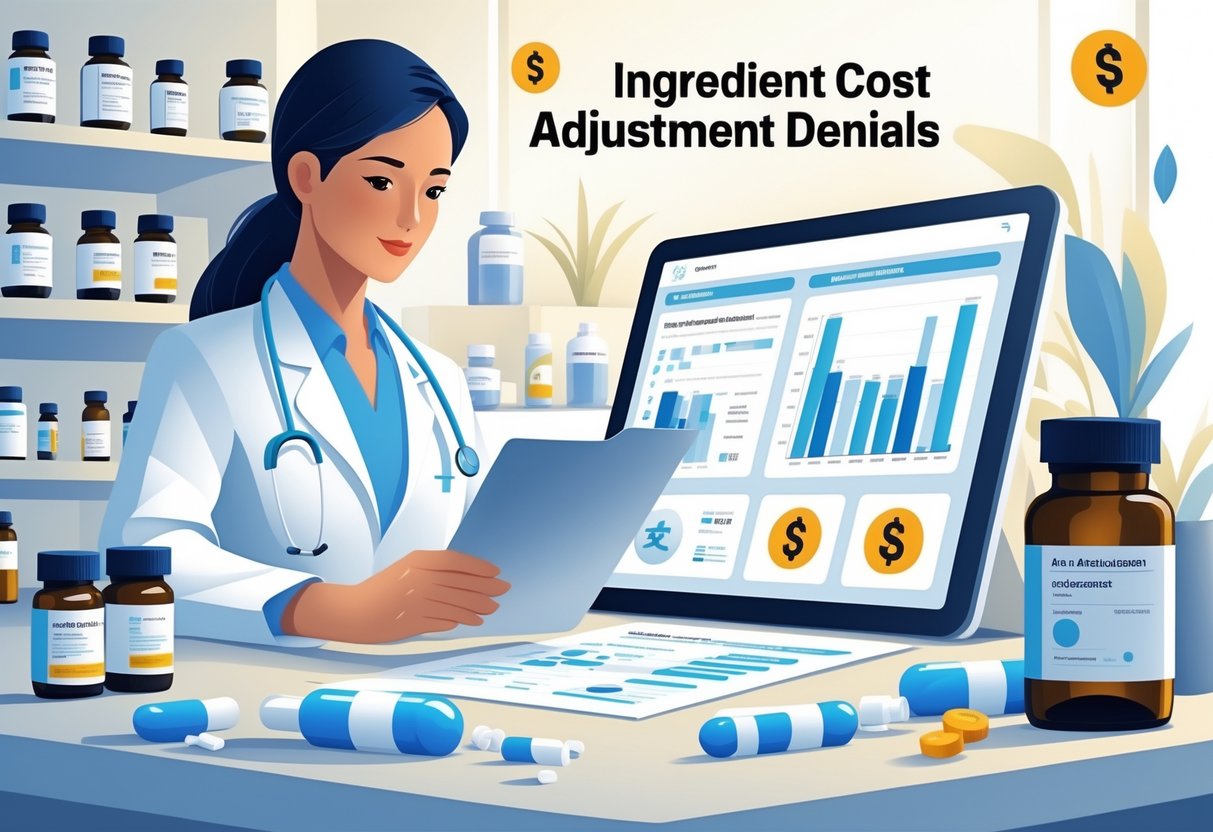If you work with pharmaceutical billing, you might come across denial code 90. This code means there is an ingredient cost adjustment related to drug charges. Denial code 90 is used only for pharmaceutical claims when the ingredient cost needs to be corrected or adjusted.
Understanding this denial can help you fix billing errors faster. It affects how much the pharmacy gets paid for the medication, so knowing why it happens helps you avoid delays in reimbursement.
By learning how to handle denial code 90, you can save time and reduce confusion in your billing process. This will keep your pharmacy claims moving smoothly and ensure payments come through properly.
Understanding Denial Code 90 – Ingredient Cost Adjustment

Denial Code 90 is used specifically to address changes in the cost of pharmaceutical ingredients. It helps ensure that reimbursement aligns with the actual ingredient costs. You will find details about its meaning, when it applies, and related rules below.
Definition and Purpose
Denial Code 90 refers to an adjustment made due to changes in the price of drug ingredients. If the ingredient cost reported during a claim does not match the approved or updated ingredient cost, this denial may be applied. Its main purpose is to correct payment amounts to reflect accurate ingredient expenses.
This code is important because ingredient costs for pharmaceuticals can fluctuate often. By using this denial code, payers make sure they are not overpaying or underpaying for drug components.
Usage for Pharmaceuticals
You should only see Denial Code 90 used with pharmaceutical claims. This code does not apply to non-drug items or services. When a pharmacy submits a claim, the ingredient cost is one factor in the total reimbursement.
If the submitted ingredient cost is too high or too low compared to preset pricing, the claim will be denied or adjusted with Code 90. This forces pharmacies to update or correct ingredient pricing before payment is made.
Key Regulatory Guidelines
Pharmaceutical ingredient pricing must follow strict rules set by health payers and regulators. Denial Code 90 must comply with guidelines on how ingredient costs are calculated and updated. These rules ensure transparency and fairness in pricing.
You need to know that ingredient cost adjustments under Code 90 often require resubmission with corrected pricing. Failure to comply can result in delays or permanent denial of payment for that drug claim. Always check payer-specific instructions linked to this code.
Common Reasons for Ingredient Cost Adjustment Denials

Ingredient cost adjustment denials happen for specific, clear reasons. These include submitting wrong cost details, errors in prescription data, or changes in policies that affect how costs are calculated.
Incorrect Cost Data Submission
You may face denials if the cost data you submit for the pharmaceutical ingredient is wrong. This happens if you use outdated pricing or fail to include all the necessary cost components.
For example, submitting a lower ingredient price than the actual invoice will trigger a denial. It’s important to match the cost data exactly to your supplier’s records.
Double-check your cost reports before submission. Make sure you include handling fees and any taxes if your insurer requires them. Inaccurate cost data is the top reason for denial under code 90.
Mismatched Prescription Information
Denials also happen if the prescription information does not match the ingredient cost claim. You need to make sure the drug name, dose, and quantity are correct and consistent in all documents.
If the prescription says 30 tablets but your cost claim is based on 20, expect a denial. Insurers verify these details to prevent overcharging.
Always verify patient-specific prescription details before you submit a claim. Minor errors in descriptions or quantities can lead to a denial under code 90.
Policy Updates Affecting Ingredient Cost
Sometimes denials come from recent changes in insurer policies about ingredient cost calculations. You may think your claim fits the old rules, but insurers update policies regularly.
New rules might limit ingredient markups or change which costs you can claim. Not keeping up with these changes can cause your claims to be denied.
Check insurer bulletins or websites for policy updates. Adjust your billing practices accordingly to avoid denied ingredient cost adjustments.
Step-By-Step Process for Resolving Denial Code 90
To fix denial code 90, you must check the claim’s details carefully, make necessary corrections, and work with pharmacy benefit managers if needed. Each part of this process helps ensure your pharmaceutical claims are accurate and accepted.
Reviewing Pharmacy Claim Details
Start by examining the original pharmacy claim closely. Verify the ingredient cost listed matches the allowed amount. Check for any discrepancies in drug codes, quantities, or pricing.
Make sure the claim is for a pharmaceutical item, since denial code 90 applies only to drug ingredient cost adjustments. Confirm that pricing adjustments or discounts were submitted properly.
Look for missing or incorrect information, such as National Drug Codes (NDCs), aliquot codes, or billing units. These details affect ingredient costs and payment accuracy.
Correcting and Resubmitting Claims
After identifying errors, correct the ingredient cost or related fields in your claim. Use the pharmacy system or software to update the claim thoroughly.
Resubmit the corrected claim promptly to avoid delays in processing. Include any necessary supporting documents that show ingredient cost adjustments or price changes.
Double-check pricing guidelines to ensure compliance with payer rules before resubmission. This reduces the chance of recurring denials related to ingredient costs.
Coordinating With Pharmacy Benefit Managers
If you are unsure about the denial or ingredient cost calculations, contact the Pharmacy Benefit Manager (PBM) directly. They can clarify reimbursement policies or ingredient pricing standards.
Discuss any disputes about cost adjustments with the PBM to find a resolution. Provide clear documentation and explain why the ingredient cost should be accepted.
Stay in regular communication with the PBM during claim review. This helps speed up claim acceptance and reduces further denials for ingredient cost adjustments.
Best Practices to Prevent Ingredient Cost Denials
To avoid denial code 90, you need to focus on accurate drug pricing and reliable pharmacy software. These two areas help ensure your claims match payer requirements for ingredient costs. Attention to detail here reduces errors and speeds up reimbursement.
Validating Drug Pricing Before Submission
You must check the ingredient costs carefully before sending a claim. Use the most current pricing data from your supplier or wholesaler. Compare this with the payer’s allowable amount to catch discrepancies early.
Verify pricing on every claim, especially if prices change often. Keep documented records of your prices and sources. This proof can be useful if a denial requires you to appeal or clarify costs.
Double-check price units and quantities. An error here can cause a cost mismatch, triggering a denial. Make sure the ingredient cost aligns exactly with what was billed.
Maintaining Up-To-Date Pharmacy Software
Using updated pharmacy software helps prevent errors in ingredient cost reporting. Many systems include automatic price updates and alerts for unusual cost entries.
Make sure your system’s drug database matches the latest payer pricing files. Regular updates reduce the risk of submitting outdated cost information.
Train staff to use all software features properly. This can minimize manual entry mistakes like wrong prices or codes. Proper use of software tools leads to cleaner claims and fewer denials.
Impact of Denial Code 90 on Pharmacies and Payers
Denial code 90 affects how costs for pharmaceuticals are managed and reimbursed. It changes the financial flow between pharmacies and payers and affects daily work processes for both parties.
Financial Implications
Denial code 90 directly impacts your pharmacy’s revenue. When claims are denied using this code, it signals that ingredient costs are being adjusted. This means you may receive less payment than expected for certain drugs.
For payers, it helps control pharmaceutical spending by ensuring payments match allowed ingredient costs. However, these adjustments can lead to increased paperwork and follow-ups to resolve disputes.
Both sides must track these denials carefully to avoid lost revenue. Pharmacies should review their pricing and invoices to minimize conflicts tied to ingredient costs. Payers need clear guidelines on cost adjustments to keep their budgets balanced.
Operational Considerations
You will need to update your claim processing systems to recognize and handle denial code 90 effectively. This includes staff training on how to respond to these denials and file corrections when necessary.
Pharmacies should create a workflow to review denied claims quickly. This can help spot patterns like repeated ingredient cost issues or formula errors. Early action can reduce claim rejections and improve cash flow.
For payers, clear communication about ingredient cost policies reduces confusion. Both parties benefit from transparent documentation and timely exchanges to resolve issues linked to these denials.
Frequently Asked Questions
You will learn when denial code 90 applies, how it connects with pharmacy benefit management, and what actions you should take if you get this code. It also covers dispute options, necessary documents, and ways to prevent these denials.
What situations warrant the application of denial code 90 for ingredient cost adjustments?
This code is used when the ingredient cost billed for a pharmaceutical does not match the insurer’s allowed amount. It often happens if the pharmacy charges more than the insurer’s set price.
How does denial code 90 relate to pharmacy benefit management?
Pharmacy Benefit Managers (PBMs) control drug costs based on ingredient pricing. Denial code 90 signals a mismatch between your billed ingredient costs and the PBM’s approved prices.
What steps should a pharmacy take upon receiving denial code 90 from an insurer?
You should review the ingredient costs charged and compare them to the insurer’s allowed amount. Then, correct any pricing errors and resubmit the claim with the right ingredient cost.
Can denial code 90 be disputed by a pharmacy, and if so, how?
Yes, you can dispute it by providing proof of the actual ingredient cost. Submit invoices or purchase receipts showing your cost to the insurer or PBM for review.
What documentation is required to resolve a denial code 90 claim?
You will need invoices or purchase orders that detail the ingredient prices you paid. Clear, dated proof helps verify the accurate cost to the insurer or PBM.
Are there any preventive measures to avoid receiving a denial code 90 for ingredient cost adjustments?
Regularly check ingredient pricing against insurer guidelines before billing. Maintain accurate purchase records and communicate with PBMs to stay updated on allowed ingredient costs.







